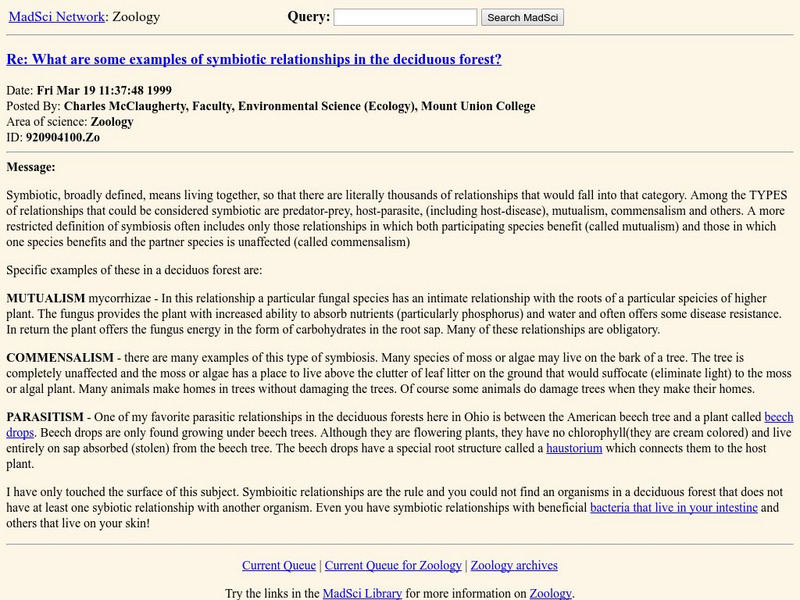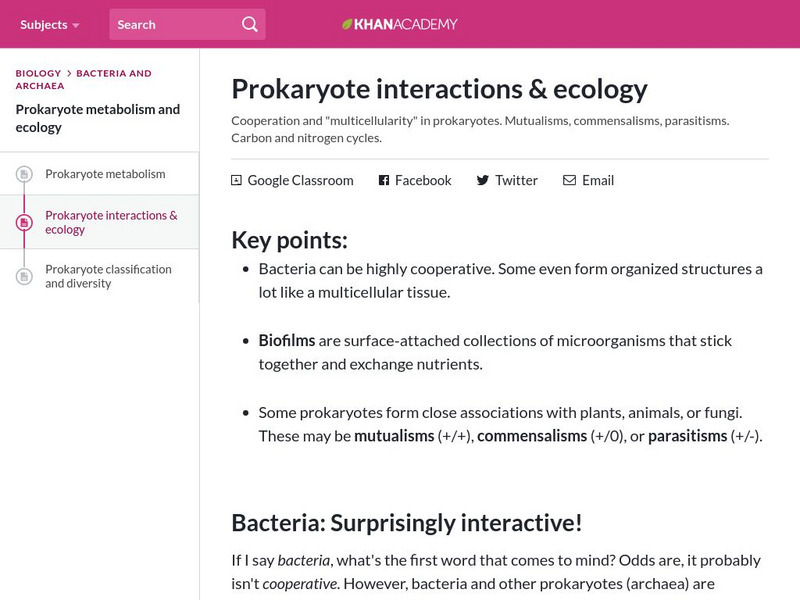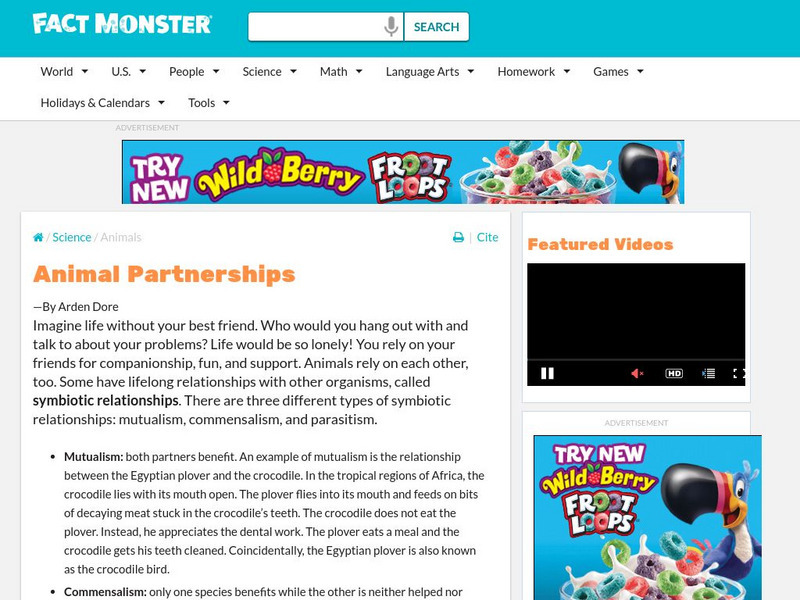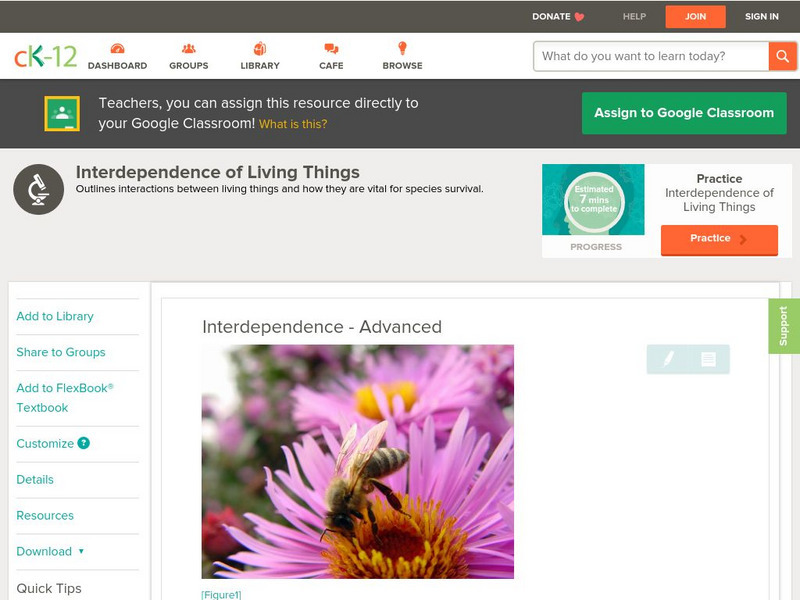Curated OER
Earth's Recyclers
Middle schoolers work together in groups to report on different topics related to decomposition. They answer questions and share their answers with the class. They discuss any topic that is unclear.
Curated OER
Fungi
Students study fungi and its parts. For this exploring fungi lesson students fill out a worksheet that includes a diagram of fungi and questions.
Scholastic
Scholastic: Study Jams! Science: Ecosystems: Symbiosis
Symbiosis is featured in this video to help students understand the process through an engaging video. Know terms like parasites and mutualism to be successful on the test.
MadSci Network
Symbiotic Relationships in the Deciduous Forest
A brief definition of symbiotic, followed by explanations of mutualism, commensalism, and parasitism.
National Geographic
National Geographic: Ecological Relationships
In this lesson, students learn about different types of ecological relationships, including symbiosis, mutualism, commensalism, and parasitism. Includes handouts and a vocabulary list with definitions.
NC State University
North Carolina State University: Symbiotic Relationships
Includes a description of symbiosis in general, then lists and defines types of symbiosis including mutualism, commensalism, parasitism, competition, and neutralism. Includes a chart which summarizes the different types of relationships....
Texas Education Agency
Texas Gateway: Symbiosis
Given scenarios or illustrations, the student will determine the nature and type of relationship between organisms, including parasitism, commensalism, mutualism, and competition.
Encyclopedia of Earth
Encyclopedia of Earth: Evolutionary Biology: Symbiosis
Article describes the different types of symbiosis, some of which are of mutual benefit, and others not. It also explains the differences between endosymbiosis and exosymbiosis, where one organism lives either inside or else upon the...
Other
The Sea Slug Forum: Symbiosis and Commensalism
Question and answer site that contains a discussion of commensalism as it pertains to sea slugs. Nice photographs of aquatic commensalistic relationships.
Khan Academy
Khan Academy: Prokaryote Interactions & Ecology
Learn about cooperation and "multicellularity" in prokaryotes including mutualisms, commensalisms, parasitisms. Also find out the role of prokaryotes in the carbon and nitrogen cycles.
CK-12 Foundation
Ck 12: Biology: Symbiotic Relationships of Fungi
[Free Registration/Login may be required to access all resource tools.] Discusses parasitic and mutualistic relationships of fungi.
Other
Pde Sas: Relationships Among Organisms
In this lesson, students compare various types of relationships among organisms (i.e., biotic interactions). Students will: explain the roles of producers and consumers, and predators and prey in an ecosystem. Explain the levels of order...
Science Struck
Science Struck: Symbiotic Relationships in the Rainforest
Explains what mutualism, commensalism, and parasitism are.
Science Struck
Science Struck: Symbiotic Relationships in the Tundra
Explains what mutualism, commensalism, and parasitism look like in a tundra biome.
Fact Monster
Fact Monster: Animal Partnerships
A description of animal relationships of mutualism (symbiosis), commensalism, and parasitism. A real life example is given for each type.
PBS
Pbs Teachers: Volcanoes of the Deep
Discuss how individual organisms and groups of organisms interact with each other, and research and classify symbiotic relationships between individual organisms of different species.
University of South Florida
Project Oceanography: Single Celled Organisms [Pdf]
In this lesson, students explore three kinds of symbiotic relationships involving unicellular organisms. They will also look more closely at the relationship between zooxanthellae and coral, and the importance of nitrogen-fixing bacteria...
PBS
Pbs Learning Media: Coral Reef Connections
Dive in and explore what makes this beautiful world so fragile. In this Web feature, from the PBS series "Evolution," discover how coevolution has shaped the ecological relationships among reef creatures.
CK-12 Foundation
Ck 12: Biology: Interdependence of Living Things
[Free Registration/Login may be required to access all resource tools.] Covers interactions between organisms.
CK-12 Foundation
Ck 12: Biology: Symbiosis
[Free Registration/Login may be required to access all resource tools.] Overview of symbiotic relationships.
Science Struck
Science Struck: Symbiotic Relationships in the Deciduous Forest
Explains what a symbiotic relationship is, the five main types of symbiosis, and provides examples of symbiotic relationships among living things in a deciduous forest.
CommonLit
Common Lit: "Can't We All Just Get Along?" by Bird Brain Science
Earth is full of a variety of living things that interact with one another in many different ways. This informational text explains the various different types of relationships they can have with one another. It also offers guided...
CK-12 Foundation
Ck 12: Biology: Community Ecology Study Guide
This comprehensive study guide covers the main terms and concepts needed for a unit on community ecology.
CK-12 Foundation
Ck 12: Life Science: 12.9 Symbiosis
Learn about the many types of symbiotic relationships in an ecosystem.















